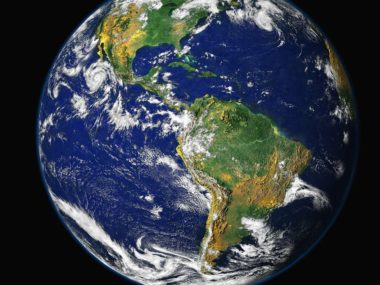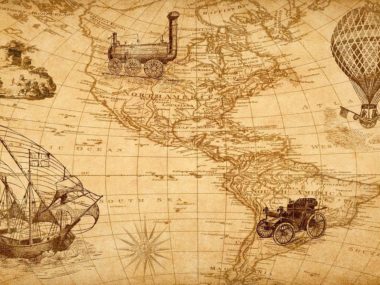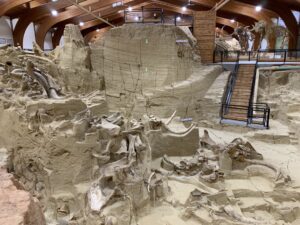But what about the science!? You can’t just ignore all the overwhelming evidence that the earth and universe are billions of years old and life evolved by natural processes. You’re an idiot!
The following article is a from The Quest: Exploring Creation’s Hardest Problems, Ch. 6, pgs. 69-78. The views expressed reflect those of the author, and not necessarily those of New Creation.

I’ve heard statements like that plenty of times from Christians and non-Christians alike. It’s usually accompanied by widened eyes, red faces, and occasional flecks of airborne spittle. My favorite email I ever received was a one-liner that said, “you are teh stupidest person in the world,” which sort of undercut its own credibility with the misspelling. Sometimes I laugh at the reactions I get, and sometimes they’re frustrating. I’d really like to have thoughtful conversations and maybe even learn new things, but more often, emotions just take over and shut everything down.
So let’s just address this right now: Am I against science or maybe even a pseudoscientist? I don’t think so. I don’t know how I could be anti-science having studied science for years, worked as a scientist, attended scientific conferences and meetings in the United States and Europe, and derived an immense amount of pleasure from doing so. As for pseudoscience, I’m not sure what that even means. I usually see it used for things that look like science but disagree with the mainstream. I’m not sure I want to use the term pseudoscience, because it mostly just strikes me as name calling. If something’s bad science or bad scholarship, I think we can just call it bad without making up fancy words just to put people down.
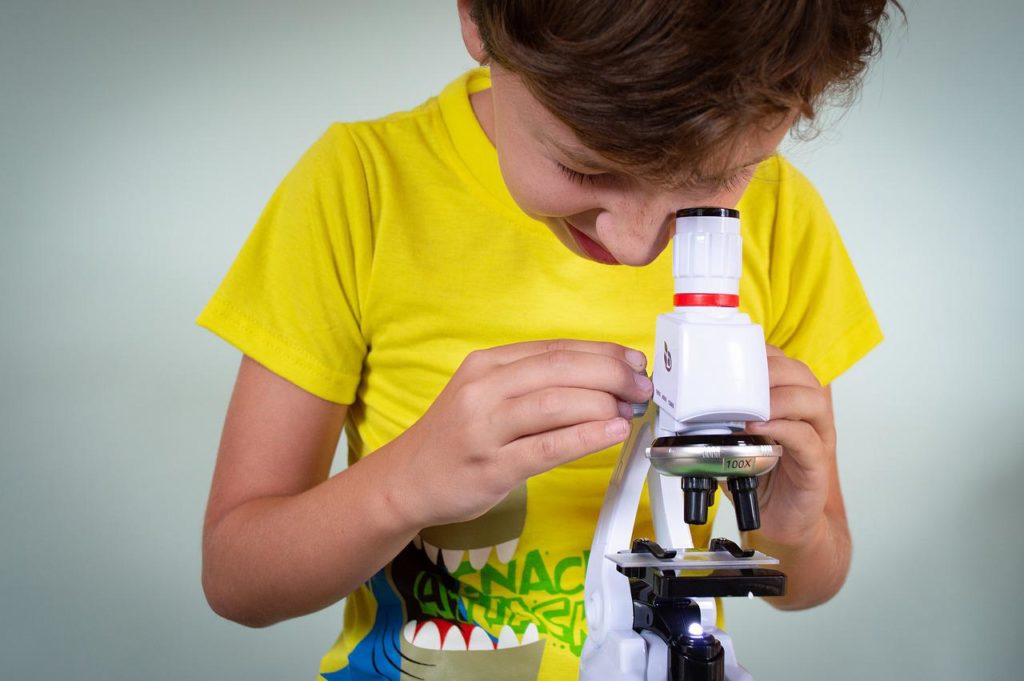
Do I ignore all of science, as many critics contend? Well, to some extent, yes, I do. After all, I’m trained only as a biochemist. I have some skill in the field of evolutionary biology and something called comparative genomics, but beyond that, I’m kind of a novice. When it comes to the age of the universe or radiometric dating or the fossil record, I must, as a matter of practical convenience, ignore much of it. I can’t, as one person, re-invent all of science. It’s just preposterous to expect otherwise.
What about the science that I do know? I confess I have a greater responsibility here. How can I claim to understand evolutionary biology and yet still hold onto young-age creationism? I’ve been answering this question in the previous chapters, as I’ve outlined my thoughts on the Bible and my faith. I know from my own experience that God is real and speaks through the pages of scripture. I am convinced by my study of scripture that it records true historical facts about the world. That’s where my thoughts about creation begin, with my own experience with the creator.
What to Do with Science
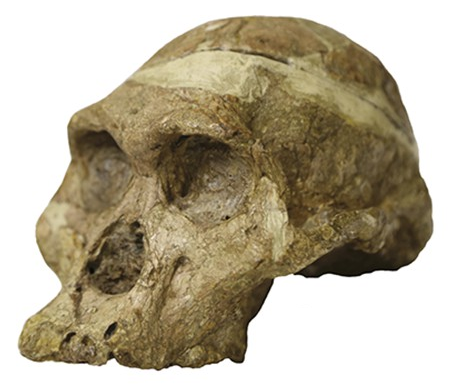
So what do I do with the science? Let’s think through the problem first. I have no doubt that evidence from creation can be interpreted as a multi-billion-year history of the world and the gradual evolution of all living things from a common ancestor. This includes evidence totally unknown in Darwin’s day, like the similarity of DNA and proteins from different species, radiometric dating, and fossils of intermediate creatures. Add to that the fact that these disparate lines of evidence appear to converge on the same explanation. This convergence is called consilience, and it’s a separate piece of evidence all by itself. Even if I could say that protein similarity doesn’t really support evolution or radiometric dating has some problems, that wouldn’t necessarily defeat evolution because the consilience of all the other evidences is still there. In my experience, consilience is probably the number one reason that people accept evolution. It’s just hard to imagine how so many different sorts of evidence could all point to the same wrong conclusion.
This is a really important point, too. I see a lot of creationists spending a lot of time, energy, and money proving this or that part of evolution is wrong. And yet, here we are. Evolutionary theory continues to grow and spread in power and influence. People are unconvinced by these efforts. Not all people, of course. There are some who find these refutations very compelling, but many more just think back to that consilience issue. It’s really hard to imagine how a conclusion with so many different pieces of evidence could be so completely wrong.
Consilient models require consilient replacements. And those replacement models must be better than the old one, or people will never let go of the old one. In the case of evolution, we can’t just be satisfied saying, “It’s wrong.” Creationists have to pony up. We have to explain what these evidences really mean and how they fit into a consilient picture of creation. That’s what I call model building, and model building is the heart of the quest.
How does one build a model? First of all, it requires knowledge of the science, and this knowledge isn’t gained by reading Wikipedia or the latest evolution book. Understanding science takes sustained, practical, first-hand study, and it needs to be guided by an expert. If you’re really serious about understanding God’s creation, that understanding really does take a Ph.D. It’s true that there are exceptions, and having a Ph.D. doesn’t guarantee you’ll be competent at science. But the average Ph.D. scientist understands their field far, far better than a guy who read a book about it. Not just any Ph.D. will do either. Creationism needs trained scientists in relevant fields. If you want to study fossils, you need a paleontology degree. If you want to study the origin of species, get an evolutionary biology degree. Don’t settle for medical studies or engineering. Just having a degree doesn’t make you an expert in everything.
That really shouldn’t come as a surprise to anyone. Science is no different than literally any other human activity. People don’t learn to drive or cook or play football just by reading books. Think about it: Would you trust your surgeon if he’d only ever read about surgery? Then why would you trust the scientific opinions of people who’ve only read about science? We should value science education guided by established and competent scientists because we value every other form of education guided by experts.
With a good scientific training in hand, how do we construct a new model that’s better than the old one? I have five suggestions that can put us on the right track:
- Think weird. A good scientist should be quick to evaluate ideas and prioritize the ones that are most likely to be worthwhile. Unfortunately, since we’re all trained in the conventional paradigm of evolution, we need to think more creatively than we’re prone to do. We need to be willing to entertain and explore even the strangest ideas, as long as they’re not obviously wrong and a waste of time.
- Think carefully. There may be parts of the conventional model that could be useful in the creation model. Not everything about evolution is necessarily wrong. Keep the good, and throw out the bad.
- Examine anomalies. Is there anything the conventional model explains poorly? Are there any errors or problems that crop up in conventional explanations? These are the sorts of things creationists get very excited about, but their real value is not falsifying conventional science. Anomalies are clues to the correct model. We need to examine them very carefully.
- Don’t take anybody’s word for it. Is there something completely settled in conventional science? Something that everyone knows is true? Look at it again. Repeat the research and try to confirm it. This has been an amazingly fruitful avenue of research for creationists.
- Think of creative ways to evaluate creationist claims. There is a rich depth and history to creationist literature, even though not all of it is worth reading. We need to be acquainted with this tradition to avoid re-inventing the wheel and to help refine old ideas and move the field forward.
These suggestions aren’t a recipe for success. They won’t guarantee a new, compelling model if we follow them. They’re only a start. They’re guides for the quest, but the quest will take time. Certainly more than one lifetime. But the end is worth it, for the end is God. Understanding God’s creation is understanding God.
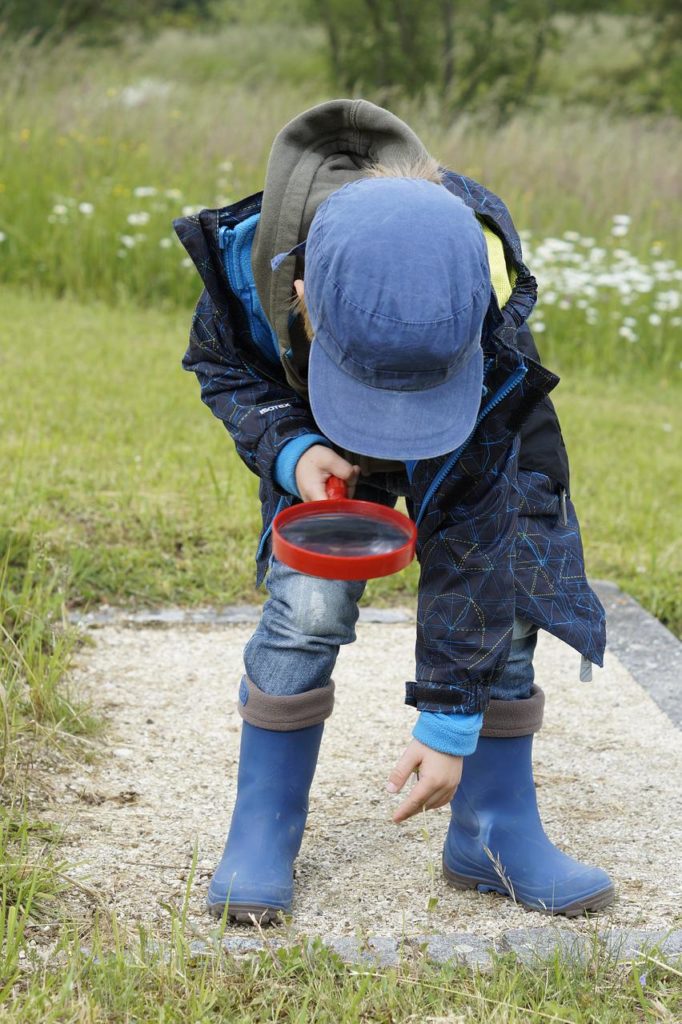
These suggestions also summarize a lot of the most successful creationist research that I’ve observed, and in that way, they loudly affirm that creationism is science. Far too often, science is understood as nothing more than knowledge. In fact, the original Latin word for knowledge, scientia, is the origin of our English word science. This is reinforced by too many tedious science classes that focus on memorizing trivia.
The real core of science isn’t knowledge though. It’s discovery. Science is a method of explaining the world around us by carefully controlled observations. Science is an activity, and it’s always growing, revising, and changing. Sometimes creationists snicker at science for not producing certain knowledge. We see headlines all the time about discoveries that call into question all sorts of accepted ideas in science, but that’s good. That’s what science should be doing. No one’s understanding of creation is perfect. Scientists should always be learning new things, making new discoveries, and revising past errors.
Science is also deeply pragmatic. Ideas that are testable, that make predictions and explain data are what scientists will work with, even if the scientists themselves are skeptical of the ideas and are only out to disprove them. The process of science can still apply, and if that works, if you can test an idea with science, then it must have been a scientific hypothesis in the first place. Even if it’s wrong.
At the beginning of this chapter, I said I didn’t really like the term pseudoscience. Personally, it just seems like an insult, but practically, it doesn’t really represent what’s happening in science. If you can find a way to evaluate your idea using science, even if it’s a terrible idea, then it has entered the world of science.
Creationism is science, or at least it can be. We may not yet have all the answers to the kinds of questions scientists want to know, but we have begun the process of studying creation and developing our alternative model.
Still don’t believe me? Let’s look at some examples.
Footprints in the Coconino
The Coconino is a layer of light-colored sandstone near the top of the rock layers exposed in the Grand Canyon. The light color makes it really recognizable, even from space. The sandstone extends across Nevada, Arizona, Utah, and Colorado. It’s well-known as a “cross-bedded” sandstone. Cross-beds are layers that run at an angle to the actual layer of the sandstone. Cross-bedded sandstone looks like it has diagonal stripes running through it.
This cross-bedding is one of the reasons geologists believe that the Coconino was formed from desert sand dunes. Cross-bedding happens when sand piles up with one angled side. In the wind, new sand blows over the top of the dune and tumbles down the side. Cross-bedding is the angled surface of ancient sand dunes. We can test this in the modern world by examining sand dunes that exist today and confirming that they also have cross-beds.
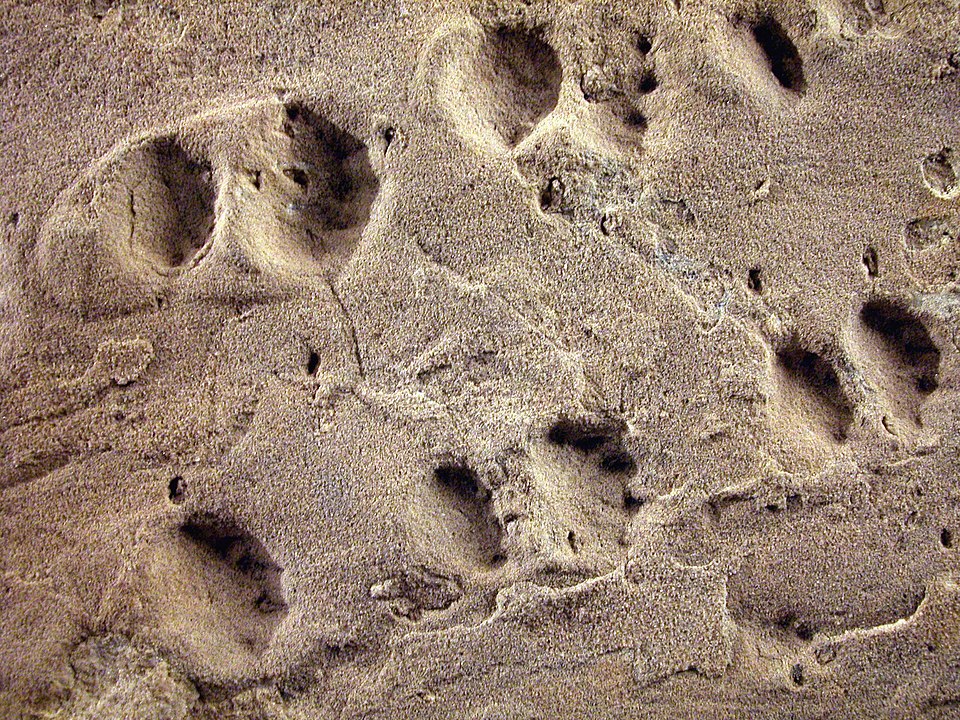
The Coconino is also known for its fossils, especially its fossil footprints. The footprints I want to talk about are the tracks of some kind of reptile or amphibian. The tracks are well-preserved. They’re small and about as wide as they are long, less than an inch overall. Four toes are visible in many of the tracks, and so is the pile of sand kicked up behind the heel.
What would a creationist think about the formation of the Coconino Sandstone? Most young-age creationists today accept flood geology, the idea that the global flood in the time of Noah is responsible for a large part of the fossil record. This Coconino Sandstone is a Permian sandstone, which means that it’s right in the middle of what most creationists believe was formed by the flood. So how could a desert sandstone form in the middle of a flood when the surface of the world was under water?
Researcher Leonard Brand examined these trackways firsthand in the Coconino Sandstone. He counted the number of tracks at his study sites, then recorded the number of footprints that preserved toe marks and the number that preserved heel marks. He found that slightly more than 80% of the tracks preserved toe marks and slightly more than 70% preserved marks from the soles of the feet. Brand observed two other weird feature of the trackways. First, the toes often pointed in the same direction but not the direction the animal was traveling. It was like the animal was doing a sidestep along the dune. Even weirder, some trackways would abruptly stop and then appear again several feet away. Could these animals fly?
Brand went back to his lab and created an artificial sand dune (also called a pile of sand) and put an orange-bellied newt on it to observe what kind of tracks it would make. Running on completely dry sand, the newt left very few toe tracks but a lot of sole marks. That should sound familiar to anyone who’s ever walked across a dry, sandy beach. Toe marks don’t last in dry sand. The sand caves in on top of them.
When the newts ran across wet sand, their toe marks were preserved very well. Every track had toe marks, but fewer than 40% preserved the mark of the sole. Neither dry sand nor wet sand seemed to be a very good match to the footprints from the Coconino. Brand also ran the newts across the surface of sand that he piled up under water. Those trackways preserved both toe marks and sole marks. A bit less than 90% of the tracks preserved toe marks, and almost 70% preserved sole marks. Tracks made underwater were the closest match to the characteristics of the fossil footprints of the Coconino Sandstone. You could even imagine an animal trying to walk while being pushed along by a water current, so the toes don’t face the direction the animal is moving, and occasionally the animal is caught up in the current and dropped down again a few feet away.1
This is one of those great examples of re-examining something everyone just knows is true. The Coconino is a textbook example of an ancient desert sand dune. In fact, Permian sandstones are known from around the world, and geologists think they’re mostly ancient sand dunes. Much to everyone’s surprise, though, Brand’s research provided one piece of evidence that the Coconino was actually formed underwater.
Fossil Hominins
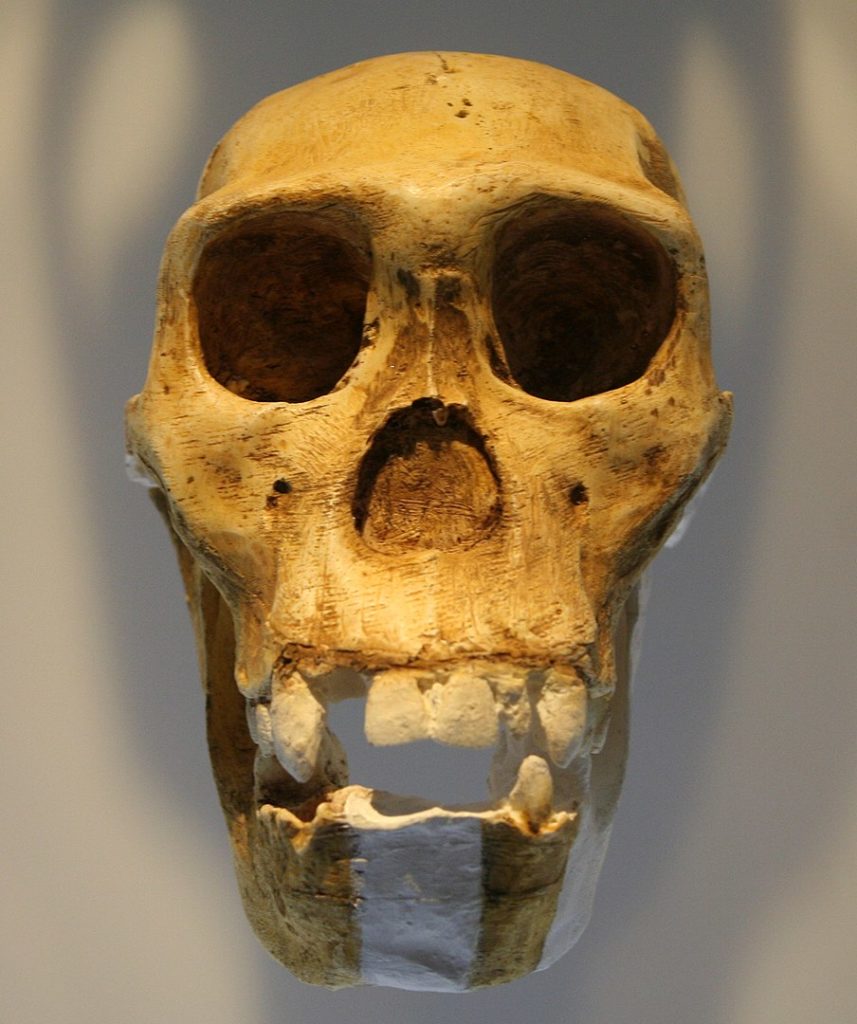
In chapter two, I described my own research with fossil hominins, the creatures in the fossil record that appear to be most similar to human beings (and some of them are human beings). As I explained there, fossil digs from the past fifty years have remarkably expanded our understanding of humans and the animals that most closely resemble us. I can definitely imagine how an evolutionist might see these discoveries as confirmation of human evolution.
My work in baraminology is an ongoing attempt to test the creationist claim that humans and apes are distinct. I already talked about my frustration with Australopithecus sediba and its consistent clustering with other creatures I took to be human. What I didn’t emphasize is the fact that there were still clusters. In other words, we could still draw a line between creatures I took to be human, like Neandertals, and creatures that were almost certainly animals, like the Lucy skeleton (Australopithecus afarensis). Even though the human group is a bit bigger than I expected, this is still a pretty exciting result. After all, with all the fossil hominins we now know about, you might expect an unbroken chain from animals like Lucy to modern human beings, but that’s not the case. Instead, we find discrete groups that do not overlap. The creationist prediction seems to be confirmed in this case. I’ve done several additional studies with fossils that have been discovered since sediba, and I keep finding the same result. Humans are humans, apes are apes, and they don’t overlap.2
Moving forward on the Quest
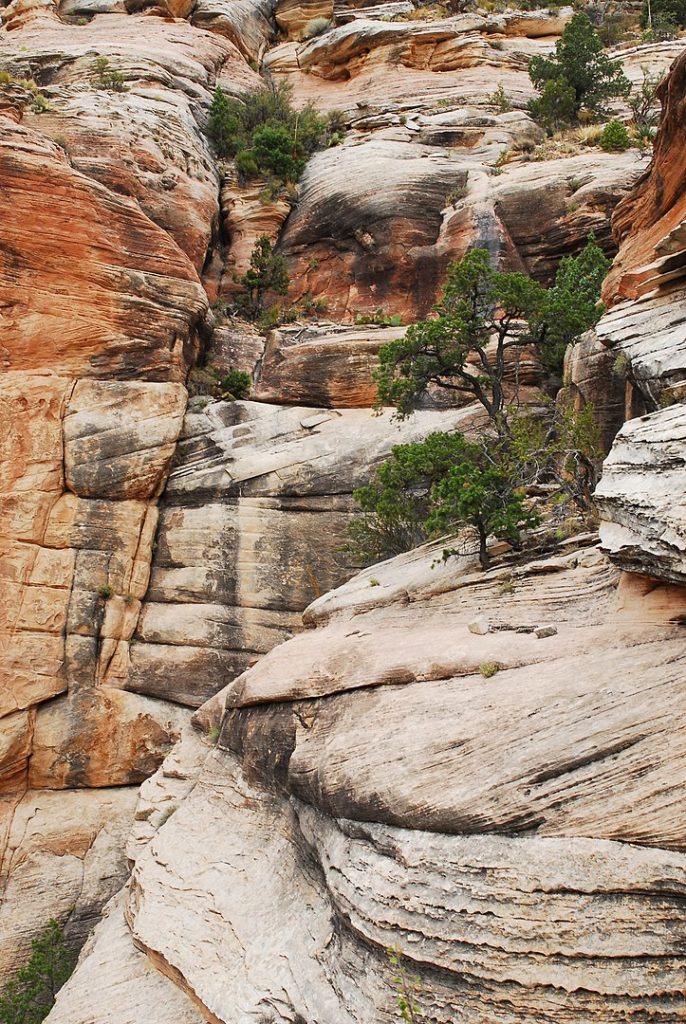
What should we make of these research results? Do they prove that creation is true after all? No, they don’t. Not at all. They raise many more questions than they answer. In his footprint research, Brand didn’t look at the cross-bedding of the Coconino, one of the classic evidences of a wind-blown sand dune. How could creationists explain that? Even if we could show conclusively that the Coconino formed under water, how would that prove the flood? There are many rock layers that are believed to have formed under water, just like there are other rock layers that are believed to have formed on dry land. There is much research still to do to fully understand the formation of the fossil record. Brand’s work is just one step.
There are questions about the hominins as well. The biggest one is the genetic evidence. Studies of the human and chimpanzee genomes since the early seventies have consistently shown a remarkable similarity between the two.3 Even if there’s a gap in the fossil record detected by baraminology, how can we explain the genomic similarity? Baraminology studies are also vulnerable to future research. What happens with the next fossil discovery? Will it also fall in the existing human or ape groups, or will it do something altogether different? Hominin baraminology is just a start.
Clearly, there is still much research to be done, but that should not diminish the success of these research projects. For me, successful projects like these act as road signs. Back in the days before satellite navigation was common, I used to navigate by studying a paper road map. While driving, I had to depend on road signs to confirm that I was on the right track. Whenever I saw the sign I was looking for, I knew I was going the right way.
So too with creationist research. As I navigate the challenging road of building a new paradigm, I rely on these small successes to remind me that I’m on the right road. These successes are like God encouraging me to keep going and not give up. The quest to replace conventional science with a new model perhaps isn’t so crazy after all. I find in these small victories a reminder that this quest is actually going somewhere.
This encouragement is called hope. This isn’t hope in the sense of wishing for something, but hope in the biblical sense of faith that looks forward. Let’s face it, the quest for God often begins with the absurd. God tells an old man that his wife will have a baby. God calls a murderer in hiding to free his people from slavery. God tells His army to conquer a city by marching around it in silence. What sense does any of this make? None, except that God’s foolishness far surpasses any human attempts at wisdom.
But where God calls, he also gives faith and hope to those who ask. Faith comes by hearing the Word of God, as I study to know him better and to understand what he revealed about his creation. Hope comes from putting that faith to the test. Will God’s promises really work in the real world? Can I test things like the Coconino Sandstone or the Neandertals and make sense of what God has said? Hope grows with success.
There is nothing new about this evolution business. The God who called Elijah and Jeremiah to stand against culture and kingdom is still God today. The God who calls us again and again to believe the impossible is the God who parts the Red Sea, brings water to the desert, and raises the dead. God’s in the business of doing the impossible. He gives faith, and he gives hope.
Footnotes
- Brand, Leonard. 1979. “Field and Laboratory Studies on the Coconino Sandstone (Permian) Vertebrate Footprints and their Paleoecological Implications.” Palaeogeography, Palaeoclimatology, Palaeoecology 28: 25-38. ↩︎
- Wood, T.C. 2016. “An Evaluation of Homo naledi and ‘Early Homo’ from a Young-Age Creationist Perspective.” Journal of Creation Theology and Science Series B: Life Sciences 6: 14-30. ↩︎
- The Chimpanzee Sequencing and Analysis Consortium. 2005. “Initial Sequence of the Chimpanzee Genome and Comparison with the Human Genome.” Nature 437: 69-87. Wood, T.C. 2006. “The Chimpanzee Genome and the Problem of Biological Similarity.” Occasional Papers of the BSG 7: 1-18. ↩︎





